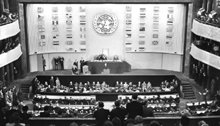Universal Declaration of
Human Rights
AN INTRODUCTION
On October 24, 1945, in the aftermath of World War II, the United Nations came into being as an intergovernmental organization, with the purpose of saving future generations from the devastation of international conflict.
The Charter of the United Nations established six principal bodies, including the General Assembly, the Security Council, the International Court of Justice, and in relation to human rights, an Economic and Social Council (ECOSOC).
The UN Charter empowered ECOSOC to establish “commissions in economic and social fields and for the promotion of human rights….” One of these was the United Nations Human Rights Commission, which, under the chairmanship of Eleanor Roosevelt, saw to the creation of the Universal Declaration of Human Rights.
The Declaration was drafted by representatives of all regions of the world and encompassed all legal traditions. Formally adopted by the United Nations on December 10, 1948, it is the most universal human rights document in existence, delineating the thirty fundamental rights that form the basis for a democratic society.
Following this historic act, the Assembly called upon all Member Countries to publicize the text of the Declaration and “to cause it to be disseminated, displayed, read and expounded principally in schools and other educational institutions, without distinction based on the political status of countries or territories.”
Today, the Declaration is a living document that has been accepted as a contract between a government and its people throughout the world. According to the Guinness Book of World Records, it is the most translated document in the world.
>> Read the full text of the Declaration



 Prev
Prev





